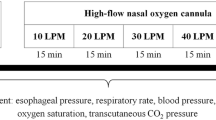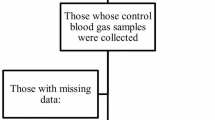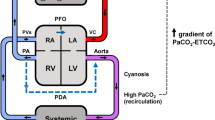Summary
The aim of this study is to evaluate the variations of respiratory gas concentration with transcutaneous blood gas measurements (tcm PO2; tcm PCO2) during intermittent positive pressure ventilation (I.P.P.V.) and aerosol therapy in patients (5 female, 5 male; 43–75 years) with chronic obstructive pulmonary diseases (COPD) with haemo gas analysis values PO2<76 mmHg. The subjects underwent transcutaneous blood gas monitoring, 16 minutes during therapy (I.P.P.V. or aerosol) and 14 minutes of recovery. ANOVA analysis of variance was used for statistical analysis. During I.P.P.V. tcm PO2 increase from the base value (60.6±9 mmHg) already after 2 minutes until the 16th minute (69.7±9); 2 minutes after the end of I.P.P.V. tcm PO2 falls below the basic one (57.6±7) and then exceeds the basic value until the 14th minute (63.5±10) (p=ns). The base tcm PCO2 (41.2±7) decreases reaching the maximum decrement at the 16th minute of therapy (32±6.6); at the end of I.P.P.V. it increases without exceeding the base value (39.5±7) (p<0.01). During aerosol therapy, tcm PO2 increases from the basic one (62.4±10) (maximum after 16 minutes 70±9.5), then it decreases (64±11) and increases againg reaching the maximum growth after 14 minutes of recovery (65.7±11) (p=ns). The tcm PCO2 values show a decrement below the base value (42.7±4.5) reaching its maximum at the 16th minute of therapy (38.8±7); at the end of aerosol the tem PCO2 increases (42.5±4.6) (p=ns). The tcm PO2 variations (I.P.P.V. vs aerosol) did not show any significant statistical difference. At the end of the therapies the tcm PO2 falls a little more after I.P.P.V. than after aerosol (57.6±7.3 vs 64±11, p=ns); the tcm PCO2 base values are similar during the two therapies (41.2±7 vs 42.7±4.5, p=ns), but the tcm PCO2 decrements reach a significant statistical difference after 8–10–12–16 minutes (p<0.05); during the recovery time after 2 minutes (34±6.5 vs 40±6.3, p<0.05) and this difference disappeared at the last recording. We calculate the tcm PO2 increment and the tcm PCO2 decrement from the base value. The tcm PO2 increment is higher during I.P.P.V. than during aerosol therapy. The tcm PCO2 decrement shows how the tcm PCO2 falls during I.P.P.V. and how these values remain below the base one until the end of the rest time. Data reported here demonstrate that mechanical physiokinesi therapy improves COPD ventilation so that the respiratory pattern could be ameliorated and preserved.
Similar content being viewed by others
References
Bosi G. P., Dotti A., Errera D., Foglio C., Ferol. Di P., (1985) —PO 2−PCO2 arterioso e transcutaneo: misure contemporanee e stabilità della differenza. In «1o Simposium sul Monitoraggio Transcutaneo in Fisiopatologia Respiratoria», Ed. A. De Mori, 30–34.
Christensen E.F., Nedergaard T., Dahi, R., (1990) —Long-term treatment of chronic bronchitis with positive expiratory pressure mask and chest physiotherapy. Chest,97:645–650.
Grassi C., Pozzi E., (1981) —Pneumologia. II Ed. Minerva Medica, Torino.
Grassino A., (1989) —Inspiratory muscle training in COPD patiens. Eur. Respir. J.2 (Suppl. 7): 581s-586s.
Green M., (1989) —Respiratory muscle rest. Eur. Respir J.,2 (Suppl. 7):578s-580s.
Kerby G.R., Mayer L.S., Progleton S.K., (1987) —Nocturnal positive pressure ventilation via nasal mask. Am. Rev. Respir. Dis.,135:738–740.
Muiesan G., Sorbini C.A., Grassi V., (1987) —Pneumologia. Ed. UTET, Torino, 617–621.
Oldenburg F.A., Dolovich M.B., Montgomery J.M., Newhouse M.T., (1979) —Effect of postural drainage, exercise and cough on mucous clearance in chronic bronchitis. Am. Rev. Resp. Dis.,120:739–745.
Schmidt S., (1988) —Methodology and clinical value of transcutaneous blood gas measurements in the foetus. J. Perinat. Med.,16(1):95–105.
Severinghaus J., (1978) —Problems of calibration and stabilization of Tc.pO 2 electrodes. Acta Anaesth. Scand. Suppl.68:58.
Spence W.A., McCollum P.T., McGregor I.W., Sherwin S.J., (1985) —The effect of the transcutaneous electrode on the variability of dermal oxygen tension changes. Clin. Phys. Physiol. Meas.,6:139–145.
Sutton P.P., Pavia D., Bateman J.R.M., Clarke W., (1982) —Chest physiotherapy: a review. Eur. J. Respir. Dis.,63:188–201.
Sutton P.P., Parker R.A., Webber B.A., Newman S.P., Garland N., Lopez-Vidriero M.T., Pavia D., Clarke S.W. (1983) —Assessment of the forced expiration technique, postural drainage and directed coughing in chest physiotherapy. Eur. J. Resp. Dis.,64:62–68.
Sutton P.P., Lopez-Vidriero M.T., Pavia D., Newman S.P., Webber B., Parker R.A., Clarke S.W., (1985) —Assessment of percussion, vibratory-shaking and breathing exercise in chest physiotherapy. Eur. J. Respir. Dis.,66:147–152.
Wasserman K., Sue D.Y., Casaburi R., Moricca R.B., (1989) —Selection criteria for exercise training in pulmonary rehabilitation. Eur. Respir. J.,2 (Suppl. 7):604s-610s.
West J.B., (1979) —Meccanica del respiro. In «Fisiologia della Respirazione (L'essenziale), Ed. Piccin. Padova, 84–109.
West J.B., (1980) —Ventilazione meccanica. In «Fisiopatologia Polmonare (L'essenziale). Ed. Piccin, Padova, 182–196.
West J.B., (1983) —Disturbances of respiratory function. In «Principles of Internal Medicine. Harrison's. X Ed., International Student Edition, McGraw-Hill, 1500–1508.
Author information
Authors and Affiliations
Rights and permissions
About this article
Cite this article
Zennaro, M., Greco, M., Croci, M. et al. Respiratory gas monitoring in patients with chronic respiratory failure during intensive positive pressure ventilation vs aerosol therapy. Aerobiologia 8, 163–174 (1992). https://doi.org/10.1007/BF02291346
Issue Date:
DOI: https://doi.org/10.1007/BF02291346




